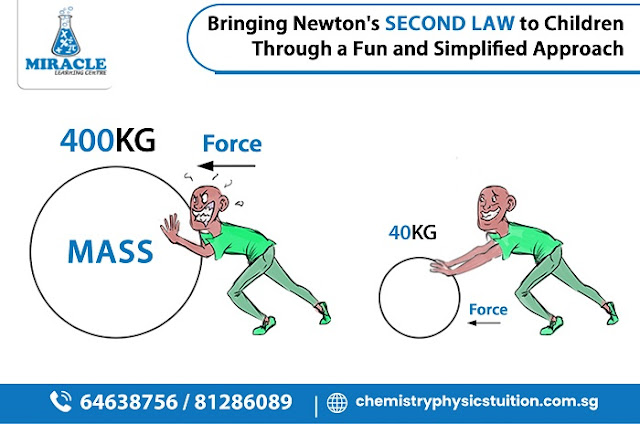Take a comprehensive look at the nuances of different motions
Motion, an elemental concept in physics, intricately weaves through the fabric of our physical world, describing the ever-changing positions of objects in relation to their surroundings. From the rhythmic oscillation of a pendulum to the complex trajectory of a satellite orbiting the Earth, the study of motion unveils a diverse tapestry of phenomena. This exploration delves into the foundational principles of motion, highlighting the factors that govern it, and subsequently, unveils the various types of motion that exist in the intricate dance of the universe. With the aid of physics tuition, we embark on a journey that simplifies these complexities, providing invaluable guidance and support for a comprehensive understanding of motion's nuanced intricacies.
Basic Principles of Motion:
Motion hinges on fundamental principles that define its dynamic nature. Time, a constant backdrop, chronicles the unfolding events. Speed, a key metric, quantifies an object's rate of progress through space. Distance encompasses the total path covered, while displacement represents the shift in position.
· Time: The continuous canvas framing motion's narrative.
· Speed: The quantitative measure of an object's swiftness.
· Distance: The overall path covered by an object.
· Displacement: The vector indicating a position shift.
Types of Motion:
Motion is a multifaceted concept in physics, encompassing a variety of forms that dictate how objects move and interact in the physical world. Let's explore each type of motion in detail, examining their characteristics and real-world examples.
Oscillatory Motion:
Oscillatory motion involves the repetitive back-and-forth movement of an object around a central point.
· Characteristics: The motion is periodic, with the object returning to its starting position after a fixed interval.
· Examples: The swinging of a pendulum, the vibrations of a guitar string, and the motion of a child on a swing exemplify oscillatory motion.
Rotational Motion:
Rotational motion occurs when an object rotates around a fixed axis.
· Characteristics:The object spins around a center, and its position is described in terms of angles.
· Examples:The spinning of a wheel, the Earth's rotation on its axis, and the motion of a fan blade illustrate rotational motion.
Translational Motion:
Translational motion refers to the linear movement of an object from one point to another.
· Characteristics: The object moves along a straight path, and its position is defined by distance and direction.
· Examples: A car moving along a straight road, a person walking in a straight line, and a train travelling on tracks showcase translational motion.
Periodic Motion:
Periodic motion involves the repetitive occurrence of a particular motion at equal intervals of time.
· Characteristics: The motion repeats itself regularly, creating a predictable pattern.
· Examples: The Earth's revolution around the Sun, the bouncing of a ball, and the heartbeat are instances of periodic motion.
Circular Motion:
Circular motion occurs when an object moves in a circular path around a fixed center.
· Characteristics: The object constantly changes direction while maintaining a consistent distance from the center.
· Examples: Planets orbiting the Sun, a satellite in Earth's orbit, and the motion of a spinning top demonstrate circular motion.
Linear Motion:
Linear motion describes the movement of an object in a straight line.
· Characteristics: The motion occurs along a single dimension, and the object's position is defined by distance.
· Examples: A ball rolling down a ramp, a sprinter running in a straight line, and the sliding of a drawer showcase linear motion.
Uniform Motion:
Uniform motion is characterized by constant speed and a consistent direction.
· Characteristics: The object covers equal distances in equal intervals of time.
· Examples: A car moving at a constant speed on a straight road, a train traveling without acceleration, and an airplane in level flight represent uniform motion.
Non-Uniform Motion:
Non-uniform motion involves variations in speed during an object's movement.
· Characteristics: The object's velocity changes over time, indicating an uneven motion pattern.
· Examples: A car accelerating or decelerating, a cyclist navigating through hilly terrain, and a rocket launching into space display non-uniform motion.
Understanding these types of motion provides a comprehensive framework for analyzing and predicting the behaviour of objects in different scenarios, offering valuable insights into the underlying principles that govern the physical world.
How Physics Tuition Simplifies Understanding
Unlocking the secrets of motion becomes an enriching experience through the tailored guidance provided by physics tutors. These mentors, adept in unravelling the complexities of physics, serve as navigators through the intricacies of motion dynamics. Physics tuition stands as an invaluable resource, employing skilled tutors who decode abstract theories into tangible insights.
By infusing interactive learning and personalized attention, physics tutors facilitate a profound understanding of motion concepts. From real-world applications to hands-on experiments, these mentors transform the learning journey into an engaging exploration.
For those seeking a comprehensive grasp of motion principles, the expertise offered by physics tuition, especially with dedicated physics tuition in Singapore, paves the way for a seamless and enlightening educational experience.



Comments
Post a Comment